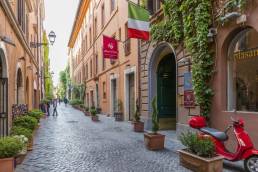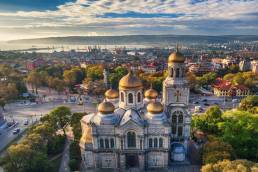Bansko is located in the Pirin mountain range in Bulgaria at 1200 meters (3900 feet) above sea level and is located at the foot of Mount Vihren, in the south-east of the country, and is a cult location for all nature lovers or for those who simply love being outdoors. Friendly and welcoming place, with a great mix of nationalities and age groups with many sporting activities to enjoy, from skiing in winter to mountain biking, climbing and hiking in summer. As well as having virtually all outdoor sports on your doorstep, it's just a two-hour drive from the Greek coast. A simply adorable city and, unfortunately or fortunately, still not very involved in European tourist circuits, although it would have all the trappings to be able to aspire to be among the most attractive names for winter and summer tourism. In this guide we thought we would collect the 5 most beautiful attractions of Bansko for our Italian customers who have moved to Bulgaria, or who want to learn about it.
Ski and snowboarding
Bansko is the most famous ski resort in Bulgaria. It is located between three mountain ranges with the ski area at an altitude of 2000–2600 meters, which means it has reliable snow cover from December to March. It has around 70 km of slopes with a mix of levels: eight blue slopes, 11 red and two black. Consider that the Tzarna Mogila ski lift that connects it has not operated for years, so the ski area is concentrated around Bunderishka and Shiligarnika. Bansko has had a lot of recent investment, so the ski lifts are modern and fast. Buses are included in the ski pass. There are plenty of cafes dotted around the slopes for a drink or something to eat. Ski and snowboard lessons are cheap and the instructors speak good English. There is also a slope for beginners, the Ski Road, a 15km tree-lined track.
Walk in the historic center of Bansko
Strolling the narrow cobbled streets in absolute peace and tranquility features prominently on our list of the best things to do in Bansko. The charming old-fashioned atmosphere of the Old Town is not spoiled in the slightest by the tourist boom of recent years. One of the main attractions of the Old City is the imposing Church of the Holy Trinity with beautiful frescoes inside and a lovely peaceful garden within the church walls. Don't forget a visit to the 30 m high slightly inclined bell tower with a view over the town.
Birthplace of Neofit Rilski
One of Bulgaria's most beloved historical figures is Neofit Rilski, who was an important figure in the Bulgarian national revival movement. He was born in the mountain town of Bansko and his childhood home has been transformed into a museum dedicated to his legacy. An educated monk, celebrated teacher and talented artist, Neofit Rilski revolutionized education in Bulgaria and is best known for his work in standardizing Bulgarian grammar and translating the New Testament into Bulgarian for the first time. His birthplace, in the center of Bansko, is a must-see to give a slightly more cultural nuance to a holiday in the city.
Summer activities
Bansko is wonderful in winter but wonderful in summer when the white of the glaciers gives way to a lush green where you can delight from June to late October. For example, you can decide to start from the ten trailheads around Bansko on routes that vary in difficulty but are mostly accessible to people of all ages. In all there are 200 kilometers of trails within moments of the hotels. Finally, for the more prepared there are 21 climbing walls taking advantage of the Pirin peaks.
What to eat
This guide is still aimed at Italians and therefore we cannot fail to include in these guides some indications on what to eat and drink in Bansko. Two above all: the first, the Katino meze. Typical Bulgarian dish that is usually served as an appetizer. It consists of small pieces of pork and veal that are fried in oil with leeks, peppers and onions. These ingredients are then baked or stewed in a clay pot with mushrooms and white wine, all garnished with parsley before serving. To drink is Melniki, an alcoholic beverage derived from Shiroka Melnishka Loza, an ancient late-ripening Bulgarian vine that is grown mainly in the south-western parts of the country, in the regions of Melnik, Petrich and Sandanski. The grape produces age-worthy varietal wines that are rich in tannins and typically display notes and aromas of cherries, strawberries and stone fruit, while mature varieties develop into more complex nuances of tar, leather and spice.



